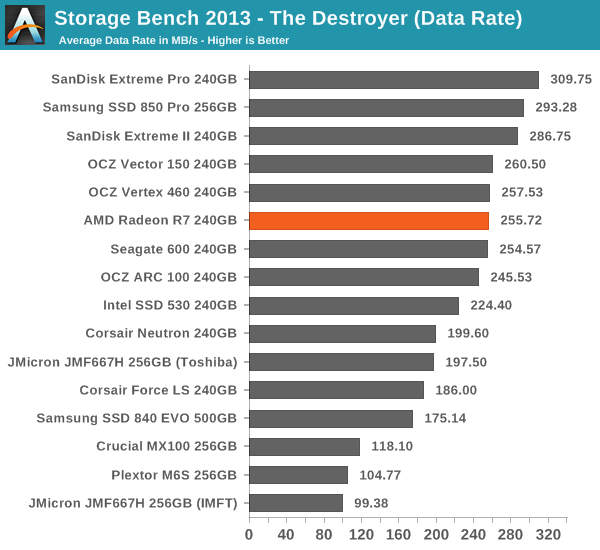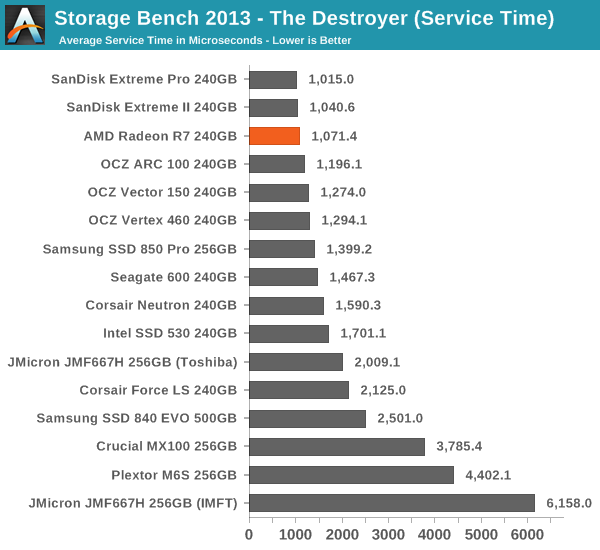AMD Radeon R7 SSD (240GB) Review
by Kristian Vättö on August 28, 2014 6:00 AM ESTAnandTech Storage Bench 2013
Our Storage Bench 2013 focuses on worst-case multitasking and IO consistency. Similar to our earlier Storage Benches, the test is still application trace based – we record all IO requests made to a test system and play them back on the drive we are testing and run statistical analysis on the drive's responses. There are 49.8 million IO operations in total with 1583.0GB of reads and 875.6GB of writes. I'm not including the full description of the test for better readability, so make sure to read our Storage Bench 2013 introduction for the full details.
| AnandTech Storage Bench 2013 - The Destroyer | ||
| Workload | Description | Applications Used |
| Photo Sync/Editing | Import images, edit, export | Adobe Photoshop CS6, Adobe Lightroom 4, Dropbox |
| Gaming | Download/install games, play games | Steam, Deus Ex, Skyrim, Starcraft 2, BioShock Infinite |
| Virtualization | Run/manage VM, use general apps inside VM | VirtualBox |
| General Productivity | Browse the web, manage local email, copy files, encrypt/decrypt files, backup system, download content, virus/malware scan | Chrome, IE10, Outlook, Windows 8, AxCrypt, uTorrent, AdAware |
| Video Playback | Copy and watch movies | Windows 8 |
| Application Development | Compile projects, check out code, download code samples | Visual Studio 2012 |
We are reporting two primary metrics with the Destroyer: average data rate in MB/s and average service time in microseconds. The former gives you an idea of the throughput of the drive during the time that it was running the test workload. This can be a very good indication of overall performance. What average data rate doesn't do a good job of is taking into account response time of very bursty (read: high queue depth) IO. By reporting average service time we heavily weigh latency for queued IOs. You'll note that this is a metric we have been reporting in our enterprise benchmarks for a while now. With the client tests maturing, the time was right for a little convergence.

Performance in our 2013 Storage Bench is typical Barefoot 3, although it appears that both the R7 and ARC 100 are more optimized for small IOs given that they provide a lower service time, yet the data rate is marginally slower.











54 Comments
View All Comments
yannigr2 - Thursday, August 28, 2014 - link
Fear only Intel and Nvidia buttons in the front page. An AMD button is just an AMD button. AMD's pockets are empty to influence Anandtech like the other two firms are already for years and without front page buttons influencing other major sites.yannigr2 - Thursday, August 28, 2014 - link
I can only explain like this the high price compared with other disks that perform the same- It targets AMD fans who are willing to pay a little extra for the sticker with the "Radeon" brand on it.
- Rebranding and selling someone else's disk does add extra costs.
- It's not meant really for retail. This is a disk that will improve the total package that an OEM will take from AMD.
SleepyFE - Thursday, August 28, 2014 - link
I think the drive is a bit much for OEMs. That said, it would be good if PCs under 600$ came with an SSD.ExarKun333 - Thursday, August 28, 2014 - link
Seriously AMD? The pricing is terrible and you are essentially looking to sell an inferior product for more than a superior one. Why? smhDoach - Thursday, August 28, 2014 - link
Love the SSD reviews Kristian. Very well written and informative.Curious, why haven't you tested a toshiba q pro series SSD yet? You have tested their partners SSDs but not theirs. According to other sites the performance is about the same as a samsung 840 pro, which is a top performer. The price is right also.
Would love to see you review this model. I saw the reviews on the other sites but your reviews are better in my opinion.
www.amazon.com/Toshiba-512GB-Series-Internal-HDTS351XZSTA/dp/B00FR6VM54/ref=sr_1_3?ie=UTF8&qid=1409228046&sr=8-3&keywords=Toshiba+ssd
www.tweaktown.com/reviews/6057/toshiba-q-series-pro-256gb-ssd-review-offers-great-value/index.html
Kristian Vättö - Thursday, August 28, 2014 - link
I met with Toshiba for the first time at FMS a few weeks ago and we didn't have a direct contact before that. Let me get in touch with them to see if they can send us some samples.Doach - Thursday, August 28, 2014 - link
That would be great! Looking foward to another great review.Thanks for the reply kristian.
LiviuTM - Thursday, August 28, 2014 - link
Great review, as always.Indeed, MSRP is not competitive at all.
A simple conversion shows the 512GB drive would cost ~220 Euros and that's without taking into account the taxes you pay in Europe.
There are obviously much better choices. Here in Romania you can buy the 512 GB Crucial MX100 for 207 Euros. An even better deal is the 512 GB Crucial M550 which right now is running for just 5 Euro more than MX100 (212 Euros!), after a recent 50 Euro price slash.
i don't need another SSD, otherwise I would have jumped on the offer with my eyes closed.
kyuu - Tuesday, September 2, 2014 - link
Except you can't simply convert the US price to Euros and take that as the price it would be sold for in Europe. That isn't how pricing works.You're also comparing MSRPs to "street" prices. SSDs in particular often sell for much less than their MSRP.
The_Assimilator - Thursday, August 28, 2014 - link
Now all we need are Radeon-branded motherboards and power supplies, and you could build a full system that's shit from top to bottom.